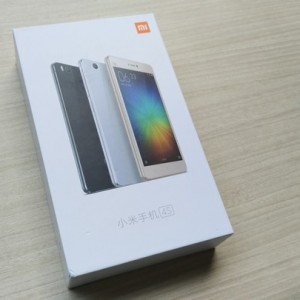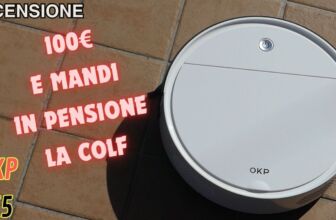
Along with the presentation of Xiaomi Mi 5 at the Mobile World Congress 2016 in Barcelona, there was also another somewhat silent and, in some ways, unexpected. We are talking about the official launch of the Xiaomi Mi 4S, a new variant of the former top of the range of the Chinese company (Xiaomi Mi 4) that after seeing three other variants of the same with more "cheap" materials, this time the situation seems to have completely reversed, seeing the adoption of much more premium materials than the Xiaomi Mi 4 itself. But will this new variant really manage to take the place of the Xiaomi Mi 4? Let's find out in this review.
Unboxing
The sales package is similar to that seen in the latest Xiaomi devices, with a white box with the image of the smartphone on the front and a sticker in the back that shows the technical specifications. Inside, we naturally find the smartphone and the usual Xiaomi accessories, that is a battery charger with a Chinese socket, a couple of manuals with the pin to extract the SIM slot (SIM / micro-SD) and a USB cable.
Before continuing, however, I think it's necessary to list the Xiaomi Mi 4S technical specifications and, more specifically, bring the supported 4G LTE bands:
- Qualcomm Snapdragon 808 hexa-core CPU (2-core A57 and 4-core A53) with Adreno 418 GPU
-
3 GB of RAM memory
-
Display from 5 "full-HD (1920 x 1080 pixels)
-
64 GB of internal memory
-
13 MP (f / 2.0) rear camera with dual LED flash (bi-tone) and PDAF
-
5MP front camera (f / 2.0)
-
Dual SIM or SIM plus micro-SD, to expand memory up to 128 GB
-
4G + with VoLTE support
-
Wi-Fi, Bluetooth, GPS, A-GPS, GLONASS, BDS
-
MIUI 7.2 based on Android 5.1.1 Lollipop
-
Battery pack from 3210 mAh
-
Fingerprint Sensor
- Size: x 139,26 70,76 7,8 mm x
-
Weight: 133 gr
As you can see, the smartphone only supports bands 1, 3 e 7. Consequently, also in this case the 8 band and 20 band are missing, so for Wind users there could be connection problems in LTE.
Design
The design of this new variant is, in my opinion, its strong point. The adoption of a glass back cover gives a very premium feeling, without then considering the lateral rounded shape that replaces the brick shape of the Mi 4, which allows a better grip of the device.
At the top we find the 3,5 mm audio jack, the infrared port and the second microphone for the suppression of background noise. On the right side there are the power key and the keys to adjust the volume, while on the left we have only the slot for the SIM trolley (SIM and micro-SD). In the lower part of the smartphone, however, we have the USB Type-C input, the main microphone and the speaker. In the back, we find the fingerprint recognition sensor which, having to nitpick, is too flush with the body, making its search a bit difficult in some cases. Another "defect" (if we can define it that way) is the poco oleophobicity of the rear panel, which retains fingerprints a lot. The same cannot be said of the front one, which instead is very oleofocibo, not retaining fingerprints, as well as having an excellent LCD display that is very defined and clearly visible even under sunlight.
Performance and temperature
On this point, we have already mentioned it in our previous article that we recommend reading:
The performance of the Snapdragon 808, from a certain point of view, left us a bit perplexed, as we should expect a lot from a former top-of-the-range processor, while through some tests (including Antutu) it is possible to see the clear superiority of a Snapdragon 650 (Redmi Note 3 Pro) compared to the latter. However, we would like to point out that in daily use this difference is not noticeable in the least.
Switching to temperatures, here is another weakness of the smartphone. In fact, in standby the device reaches i 30,5 ° C and during a classic use of the smartphone (internet browsing, chat, etc.) it reaches the same temperature 33,5 ° C which can be detected on the back cover, and when we measure the temperature on the side frame, we realize that it touches the 38 ° C, a bit excessive for a processor of this caliber.
Camera
The photographic sector has always been a strong point in the series Mi. Specifically, the rear one of the Xiaomi Mi 4S makes excellent shots both in bright environments and outdoors, as well as in low-light environments. The only difference that can be found compared to a Xiaomi Mi 5 is possible to notice it in the focus, which turns out to be a little slower but nothing so relevant. It also performs well in recording full-HD videos which justifies the price range at which it is sold. Finally, the front camera also performs very well, capturing a lot of light and returning great photos. Here are some un-retouched photos including an outdoor photo, a low-light photo, a macro and a panoramic photo.
Battery
As for the battery life we are of poco below the levels of the Xiaomi Mi 5, managing to cover a whole non-stressful day, on the contrary it will turn off in the afternoon. If on the one hand this is reassuring, on the other it makes us understand that a smartphone with such a processor in theory should be less energy-intensive than a Snapdragon 820 and therefore have greater autonomy, while this does not access.
Conclusions
With this fourth variant of the Xiaomi Mi 4, the company has made some steps forward, we do not deny it but there is a "but". The design has certainly improved compared to the Mi 4, both with the adoption of higher quality materials and with greater attention to detail (symmetry). The photos and videos are good for a device offered at this price and above all they follow the always excellent quality of the Mi series. Surely to appreciate the support for two SIMs or the possibility of expanding the internal memory via a micro-SD (although I don't think it will be necessary, since the internal 64 GB are already many). On the other hand, however, much more was expected in terms of energy from a 3260 mAh battery and a former top of the range processor. Speaking of the processor, honestly it would have been better to implement a more recent processor so as to be able to obtain not only improvements in terms of performance but also in terms of energy consumption, as well as temperatures, which in the long run creates a bit of annoyance (especially in gaming. ). In conclusion, if you are not very interested in the photographic quality and the small size, for the price at which it is offered by third-party retailers, I do not recommend buying this smartphone and opting for a Xiaomi Redmi Note 3 Pro, saving in economic terms. and earning both in terms of performance and energy, otherwise with about 100 € more you would take a Xiaomi Mi 5 32GB but you would gain from every point of view.
via | Xiaomi Fans Italia





















